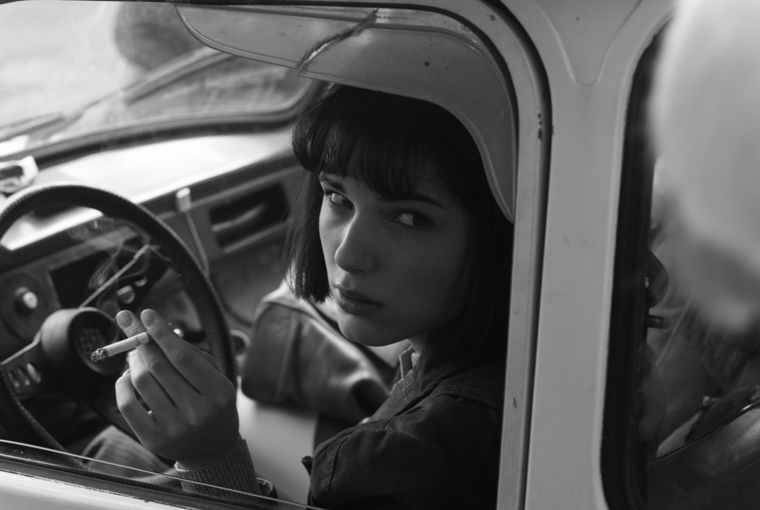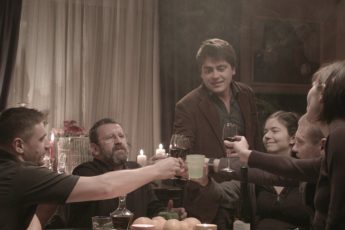Silence and Aftershock
Petr Kazda and Tomas Weinreb’s I, Olga Hepnarova (Já, Olga Hepnarová, 2016)
Vol. 63 (March 2016) by Rohan Crickmar
The audience response to Weinreb and Kazda’s debut feature was unlike anything I have witnessed in more than thirty years of cinema-going. At the end of this second Berlinale screening of the directorial duo’s existential character study of an unusual Czech murderer the film cuts sharply, and unsparingly, to black and leaves the audience apparently speechless. The concentrated silence with which the end credits rolled up the screen – white text on black background – intensified my sense that the filmmakers had managed to come up with a perfect ending. This was all the more surprising as it had seemed as if the sinuous, single-minded power of the work had been woefully undermined by a closing twenty minutes in which the film tells and explains rather than shows and suggests. For the best part of four minutes not a single body, in the cinema, stirred, and not a word was even murmured, before the obligatory Berlin courtesy of a round of applause. Even this clapping seemed to come from a slightly dazed place, as if the harshness of that closing cut still commanded more of our concentration.
I, Olga Hepnarova is very much a film crafted with an international audience in mind and it may well have enough about it to break out from the festival circuit and on to mainstream international release. Part of its power is almost certainly derived from the limited knowledge of the central character that an audience outside of the Czech Republic and Slovakia is likely to possess. The filmmakers’ decision to frame this character study as a series of unflinching stares either at, or from, the central character suggests that the object of the film is to withhold, for as long as possible, the true extent of Hepnarová’s crimes. Contrary to what one might expect, the film doesn’t really deal in glib shock tactics, and this deliberately minimalist approach only heightens the dramatic impact of Hepnarová’s eventual violent actions. It also helps to focus attention upon the depressing vagaries of Olga’s everyday existence, a mixture of sexual longing and frustration, frequently played out against family and the gender divide.
Alongside the use of a relatively ‘exotic’ subject matter that is unlikely to be well-known outside of the countries of former Czechoslovakia, the filmmakers have also employed the visual artistry of Polish DoP Adam Sikora – a veteran of international co-productions with Polish auteurs such as Lech Majewski and Jerzy Skolimowski. Sikora is working with a monochromatic palette that cannot help but evoke the recent Polish Oscar-winner Ida. What is more, much like that film, I, Olga Hepnarova has a preference for fixed camera position shot set-ups, only really breaking this patterning for obvious motion sequences involving cars and dances. Having received funding and support from the PISF (Polish Film Institute) and featuring at least two rising Polish stars, it would seem that the producers are at the very least hoping for a split domestic market between the Czech Republic, Poland and Slovakia.
So what is the film about? Who is this Olga Hepnarová? The film deals with the aftermath of the Prague Spring and Hepnarová’s angst can be seen as in some ways expressive of the entrenched oppressions of a Czechoslovakia immediately after the political and social ructions of 1968. Olga Hepnarová goes down in history as the last woman to have been executed in Czechoslovakia. She was executed on the 12th March 1975. Her execution was as a result of her desire to have her actions of the 10th July 1973 viewed as the actions of a sane individual, but one who felt deeply wronged by Czechoslovak society. Working as a delivery driver, Hepnarová had taken one of her heavy work vans and ploughed her way through 25 people waiting for a tram on a busy Prague street. The letters that she had sent to newspapers prior to undertaking this violent action listed the various different ways in which Czechoslovak society had alienated, demonized and marginalized her. These letters also demonstrated the influences of Graham Greene and Albert Camus – the former being directly referenced in the film – upon Hepnarová’s identification with a romanticized image of the nihilistic outsider.
As well as being a character study of this peculiar murderer, the film also attempts to serve as a political intervention into the contemporary debates going on within the Czech Republic, Poland and Slovakia about the reintroduction of the death penalty. During the post-screening Q&A Petr Kazda went to great pains to underscore the anti-capital punishment stance of the film. This aligns the film much more closely than is really comfortable, or productive, with Krzysztof Kieślowski’s merciless study of murder and retribution A Short Film About Killing (1988). That film is seen by many within Poland as playing a crucial role in the eventual repeal of the death penalty in the country. The films do share a murderous central character animated by existential nihilism and an inscrutable sense of being wronged by the wider society. Yet I, Olga Hepnarova is much stronger in its examination of the murderer’s existence than it is at the intersection of murderer and justice system. Whereas Kieślowski’s film spent as much time with the brutalities of the ‘justice system’ as with that of the murderer, I, Olga Hepnarova awkwardly appends this confrontation with the ‘justice system’ to what has hitherto been a deftly handled character study. This move from a narrow-focus upon Olga’s impenetrable, and often seemingly wilful, weirdness, to a more expansive look at the society that has contributed to her weirding, is where the film runs in to its greatest difficulties, almost fatally losing its focus and rigor.
What is undeniable about I, Olga Hepnarova is the quality of the central performance from Polish starlet Michalina Olszanska. This exceptionally assured young actor had already built up a formidable list of minor performances (Jack Strong, Warsaw ’44, Life Must Go On) before her breakthrough role as one of the monstrously alluring mermaid sisters in the outrageously enjoyable The Lure (a Polish film that received very positive coverage at this year’s Sundance Film Festival). It is interesting to consider how vigorously Olszanska pursued this role, effectively serving as co-producer helping to foster the film through a number of different funding meetings. In many ways the role is just the kind that an intelligent young actor craves – edgy subject matter, requiring technique and nuance, and maximizing screen time. Olszanska is barely off camera, with so much of what she is asked to do being captured in close-up and limited to the slightest modulation in eye or mouth muscles. The subtly introduced issue of gender division, also asks for the actor to fluidly move from femininity to masculinity and back again. Undoubtedly, the critical attention given to a film like Blue Is the Warmest Color (2013), has foregrounded the fashionable risk-taking legitimacy of sexually provocative homosexual roles.
The boldly enacted sexual encounters in I, Olga Hepnarova cannot help but showcase the supposed ‘daring’ of the likes of Olszanska, Marika Soposka and Marta Mazurek (the latter of whom also featured in The Lure). What makes the sexual encounters between Olga and the women she comes across so fascinating is that sense of gender dissolution that is to be found in Olszanska’s performance, and which was clearly a key directorial decision. Her character is ostensibly lesbian, and yet the psychology that the directors and actor have established for Olga make her a far more intriguing proposition. Olszanska uses small variations in physicality to suggest oscillations between masculine and feminine. This makes the directness of her first sexual encounter with Soposka almost understandable as a straight heterosexual coupling framed as an intensely physical lesbian encounter. This sense of frequent gender displacement as central to the character of Olga also works to complicate her relationship with Martin Pechlat’s Miroslav. Although a sexual encounter between these two characters is never shown, it is suggested, and can potentially be read as a homosexual dalliance masquerading as a humdrum heterosexual coupling. Olszanska deftly alternates from reticence and timidity, to a hunched and snarling, prowling masculinity. The transformation of her gait from an awkward, hesitant shuffle to a lolloping and aggressive diagonal thrust forward is just one of the more obvious transitions between potentially male and female senses of self.
Another more circumspect transition is that constructed by the directors in their attention to who Olga looks at, and, in turn, who looks upon her. Throughout the film Olga is shown to stare out at something, or someone, or there is a sense of someone staring at her. This visual patterning reveals itself so clearly because as often as Olga stares at something, she is also shown to be actively avoiding eye contact. Much like the best works of Carl Theodor Dreyer and Robert Bresson so much of I, Olga Hepnarova is contingent upon the non-reciprocal nature of looking. Very often Olga’s stares are reproachful, hostile and combative. The real strength in Olszanska’s performance lies in her decision to underplay so much of the complex psychology and frustrated physicality of Olga. Minimal movement of the eyes, a slight narrowing or widening, a sharp furrowing of the brow, this is all that Olszanska needs to create the vast distance between audience and protagonist. There is a remote quality in Olga’s eyes, but Olszanska can drop this defensive strategy to reveal bruised, wounded and frightened qualities within her character.
The directors utilize the intensity of Olga’s stare most effectively in a sequence that directly breaks the fourth wall between protagonist and audience. Moreover, it does so in a confrontational and extremely unsettling manner. Intermittently through the central part of the film Olga is shown to be struggling to hold down a job. She is also seemingly incapable of maintaining prolonged human relationships. These ‘failures’ lead her to hole herself up in her bed, seemingly ill or depressed, or both. During what I would describe as a key sequence within the film, Olga is shown in her bed, motionless and almost deathly. Her position within the frame is at the direct center of the shot. She is looking slightly away from the camera, as if observing something just beyond the lens. Crucially, the stare here lacks intensity, as if Olga has burrowed down within herself. The directors choose to hold this shot for thirty seconds, or more, demanding that the audience notice Olga’s lassitude. There is then a sharp cut from this medium shot of Olga’s cramped little hut, to an imposing close-up of Olga’s face from the top of the shoulders upwards. What is most striking about this shot is how Olga’s face is directed. Caught in portrait the face takes up almost the entirety of the screen, with the eyes locked aggressively upon the camera lens, giving the effect of Olga now staring straight out at the audience, at those of us who have been staring at her all along. She is challenging us. This sequence neatly encapsulates the attention given to, and the power created by, stares within the film, as well as neatly suggesting the division of self within Olga. It also situates the audience as another persecutory element, scrutinizing this performance of Olga, as Olga herself felt scrutinized.
The overall effect of the opening eighty minutes of I, Olga Hepnarova is that of being placed within claustrophobic proximity to a caged and wounded animal. The tendency toward minimalism in all aspects of the production, from the monochrome cinematography to the sparing use of dialogue, create a sense of austerity and purity in the directors’ approach to character. The manner in which Weinreb and Kazda then betray the potency of this approach by resorting to an explicatory addendum that strongly echoes the didactic forms of recent Polish historical cinema, such as Katyn (2007) or Baczyński (2013), only proves all the more disappointing. Such an ending makes me wonder whether this didactic form is something that isn’t solely linked to Polish historical cinema, but is in fact to be found elsewhere within countries that experienced State Socialism in the last century. Or maybe it is more reflective of the influence exerted over the production by PISF support. Either way, it is a problematic aspect of the film that diminishes its overall effect. That said it would seem fitting that the 66th Berlinale would seek to open this year’s Panorama program with such an arresting and powerful pan-Slavic co-production, as this has been traditionally an area that the Berlinale has been mindful to promote. I wonder how much of this decision was to do with the presence of the Polish director Małgorzata Szumowska on this year’s Jury?




Leave a Comment